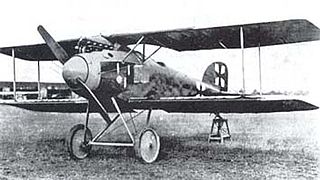
The Albatros D.II was a German fighter aircraft used during World War I. After a successful combat career in the early Jagdstaffeln, it was gradually superseded by the Albatros D.III.

The Fokker D.I was a development of the D.II fighter. The D.I was also flown in Austro-Hungarian service as a fighter trainer aircraft under the designation B.III. Confusing the matter further, both the D.II and D.I arrived at the Front in German service at similar times, in July–August 1916. The main designer was Martin Kreutzer.
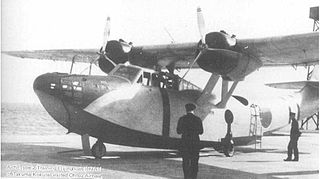
The Aichi H9A was an Imperial Japanese Navy Air Service flying boat used during the first years of World War II for crew training. An uncommon type, it was not encountered by Allied forces until spring 1945, and was never assigned an Allied reporting name.

The Aviatik (Berg) D.I, was a single-engine, single-seater biplane fighter that was developed and manufactured by the Austro-Hungarian branch of German aircraft company Aviatik. It was also known as Berg D.I or the Berg Fighter, because it was designed by Dipl. Ing. Julius von Berg, and to distinguish it from the D.I fighter built by the parent Aviatik firm in Germany.
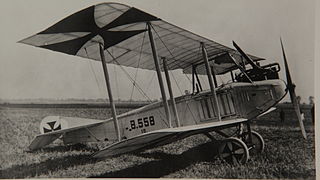
Note: Not to be confused with the Austro-Hungarian Aviatik B.II series 32, 32.7 and 34 which were different aircraft.

The Hansa-Brandenburg C.I, also known as Type LDD, was a 2-seater armed single-engine reconnaissance biplane designed by Ernst Heinkel, who worked at that time for the parent company in Germany. The C.I had similarities with the earlier B.I, including inward-sloping interplane bracing struts. Like other early-war Austro-Hungarian reconnaissance aircraft, such as C-types of Lloyd or Lohner, the Type LDD had a communal cockpit for its crew.

The Hansa-Brandenburg CC was a single-seat German fighter flying boat of World War I. It was used by both the Kaiserliche Marine and the Austro-Hungarian Navy.

The Macchi L.3, or later Macchi M.3, was an Italian biplane flying boat developed from the earlier L.2.

The Lohner L was a reconnaissance flying boat produced in Austria-Hungary during World War I. It was a two-bay biplane of typical configuration for the flying boats of the day, with its pusher engine mounted on struts in the interplane gap. The pilot and observer sat side by side in an open cockpit, and both the upper and lower sets of wings featured sweepback.
The Aviatik (Berg) D.II, the prototypes of which were known as Aviatik 30.22 and Aviatik 30.38, was an Austro-Hungarian sesquiplane fighter aircraft prototype towards the end of the First World War.
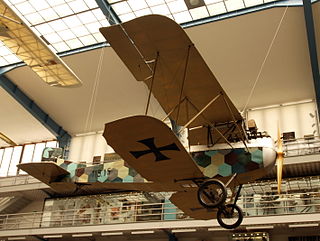
The Knoller C.II was a reconnaissance aircraft built in Austria-Hungary during World War I for use by the Austro-Hungarian army.

The Lohner B.I was a military reconnaissance aircraft produced in Austria-Hungary during World War I. As Lohner strove to perfect the design, a variety of increasingly powerful engines were fitted, reflected in a range of military designations from B.II through to B.VI until the definitive B.VII was finally produced. This last version was also produced in an armed variant, designated the C.I.

The unarmed Lohner B.VII and its armed derivative the C.I were military reconnaissance aircraft produced in Austria-Hungary during World War I. They were the ultimate developments in a family of aircraft that had begun with the B.I prior to the outbreak of war, and were the first members of that family that proved suitable for front-line service during the conflict. Like their predecessors, the B.VII and C.I were conventional biplanes with characteristic swept-back wings.
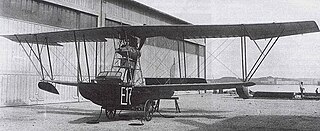
The Lohner E was a reconnaissance flying boat built in Austria-Hungary during World War I. The "E" stood for Igo Etrich, one of the Lohner engineers. It was a conventional design for its day with biplane wings that featured slight sweepback, and an engine mounted pusher-fashion in the interplane gap. Its crew of two was seated in an open cockpit.
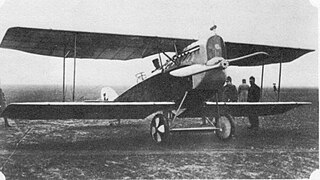
The Aviatik C.I, the prototypes of which were known as Aviatik 30.14, Aviatik 30.15 and Aviatik 30.16, was an Austro-Hungarian 2-seat reconnaissance aircraft produced from 1917.(Note: the is not part of the designation, but used to disambiguate from the German-built Aviatik aircraft with the same designation.)

The Phönix C.I, given serial numbers in the Phönix 121 range, was an Austro-Hungarian First World War reconnaissance and general-purpose biplane built by Phönix and Lloyd.

The Lloyd 40.08 Luftkreuzer was a three engine triplane bomber type built during World War I. The design was proven to be ineffective and development did not proceed past the prototype stage.

The Lloyd 40.05 was a very unorthodox experimental fighter/reconnaissance biplane produced by Lloyd (Ungarische Lloyd Flugzeug und Motorenfabrik AG / Magyar Lloyd Repülőgép és motorgyár Részvény-Társaság) in the Austro-Hungarian Empire during the First World War.
The Lohner 10.15, also known as Schichtpreis Eindecker Type 1914, Lohner A 23, Gnome-Etrich and by its c/n AD 489, was a monoplane racing aircraft designed and built in late 1913 for the 1914 Schichtpreis race. Requisitioned at the start of World War I by the Luftschifferabteilung (LA), the sole 10.15 remained active as a trainer until at least November 1917.

The Lohner M was a reconnaissance flying boat produced in Austria-Hungary during World War I.


















